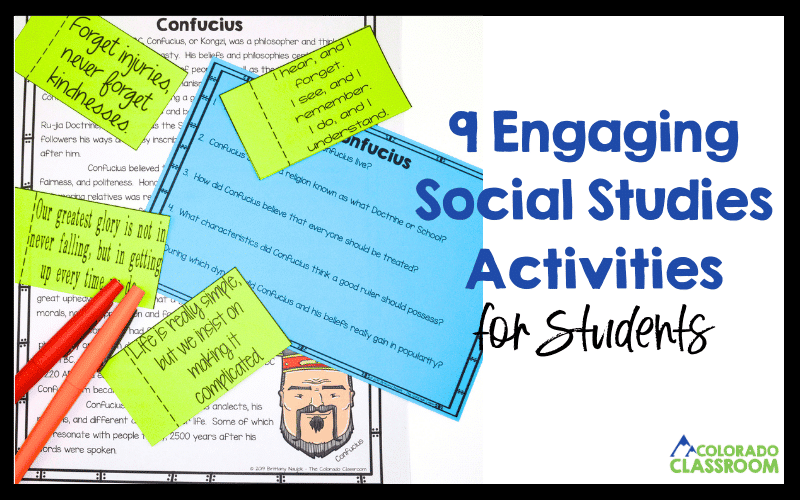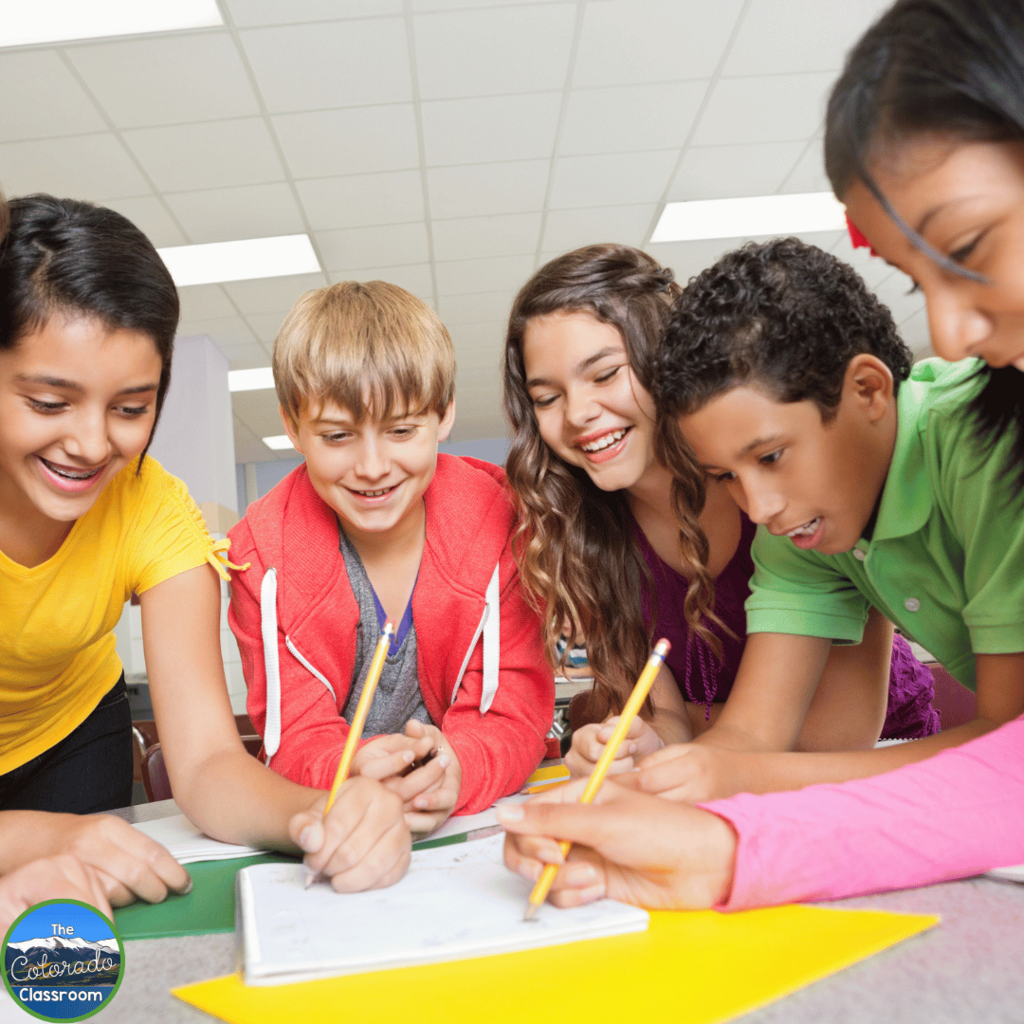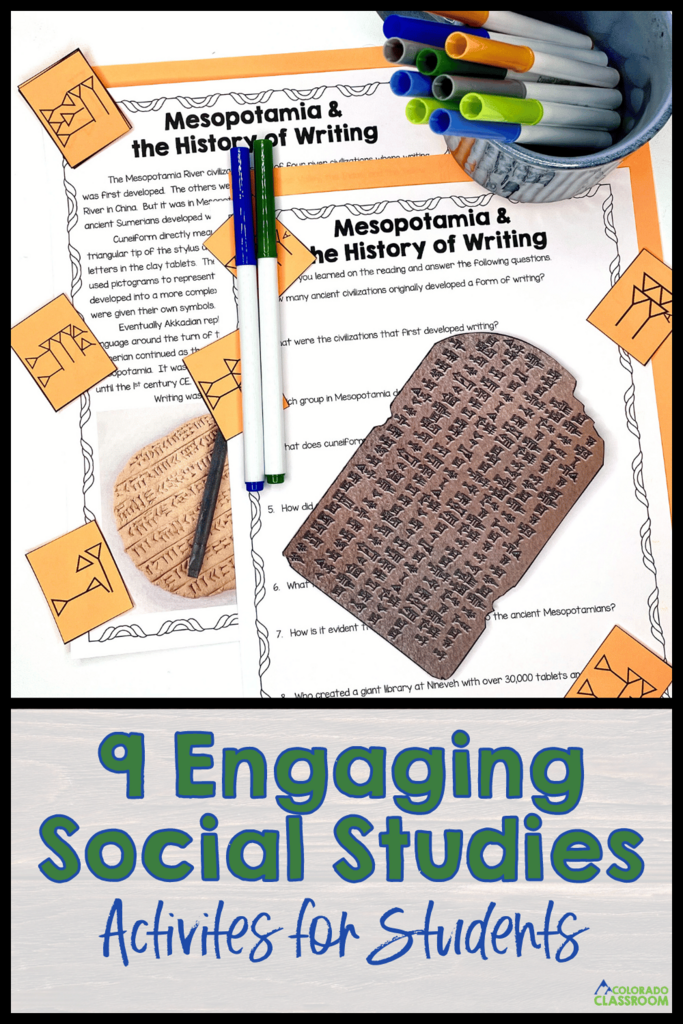9 Engaging Social Studies Activities for Students
Sometimes, I feel like social studies gets an unfair reputation for being boring. So many students think it’s just a class where they’re forced to memorize dates and names that seem irrelevant to their lives. As a social studies teacher, my mission is to show my students just how exciting and relevant history is to our everyday lives. If you’re on a similar mission, come along to see 9 engaging social studies activities that will change everything!

I recently came across a quote that really resonated with me: “We are the past’s future and tomorrow’s past.” How cool is that? It highlights the incredible idea that we are the result of the perseverance of people from the past, and the future will be shaped by what we’re doing right now. This perspective is what I strive to bring into my classroom every day.
To make history come alive, I incorporate engaging social studies activities that capture my students’ interest. Today, I’m excited to share a few of these activities with you to help increase engagement in your classroom, too!
The Impact of Engaging Social Studies Activities

Engaging social studies activities can completely transform the classroom experience by making history come alive for our students. When we create lessons that captivate and inspire, we do more than just teach. Engaging activities help students see the relevance of history in their own lives. When they connect the dots between past events and current issues, they start to understand the importance of learning from history. I love watching them have an “aha” moment. Suddenly, they’re not just memorizing facts but seeing the bigger picture.
These activities promote critical thinking and problem-solving skills. When students dive into hands-on projects, debates, and simulations, they learn to analyze information, consider different perspectives, and make informed decisions. These are essential skills that they’ll use long after they leave our classrooms.
Engagement boosts motivation and participation. When students are excited about what they’re learning, they’re more likely to participate, ask questions, and seek out additional information on their own. This enthusiasm creates a dynamic and interactive learning environment where everyone benefits.
Creating engaging social studies activities allows us to build stronger relationships with our students. They see that we care about making learning fun and relevant, which fosters a sense of trust and respect. When students feel valued and understood, they’re more likely to engage and succeed.
Engaging Social Studies Activities for Your Middle Schoolers
Now that we understand the benefits of engaging social studies activities, let’s dive into some specific ideas that can captivate our students’ interest and make learning history a truly enjoyable experience. Here are nine surefire ways you can increase engagement in your social studies classroom.
1. Use Hands-On Activities

You can’t go wrong with hands-on activities! Whether cutting, pasting, and creating foldables for your social studies notebook or bringing to life an ancient form of writing, hands-on activities are an easy way to get students excited about learning and a wonderful way to tap into a variety of learning styles.
I love using the Ancient China Confucius and Writing lesson for hands-on, engaging social studies activities. One of my favorite parts is the slat book activity, where students make a book out of tongue depressors and string. This helps them understand how Chinese writing works, and they even learn to write some common words from Confucius’ beliefs on their slat books.
The lesson includes a reading on Confucius and ancient Chinese writing, along with popular sayings from Confucius in a foldable format. We read through the article “Confucius” together, discussing his life, beliefs, the religious following he established, and how his ideas compare to today’s belief systems. After that, I pass out the maxims and have the students cut them out and glue them into their notebooks, leaving only the small tab glued down so the maxim itself can be lifted to reveal their interpretation underneath.
I usually have students work in small groups or with partners to discuss the maxims and what they think they mean. This collaborative approach not only makes the lesson more engaging but also helps students develop a deeper understanding of Confucius’ teachings.
2. Bring In Guest Speakers or Go On Field Trips
Nothing beats the excitement of a field trip! Visiting museums or historical sites or inviting guest speakers to share their expertise can provide your students with a fresh perspective and a real-world connection to what they’re learning. If an in-person visit isn’t doable, consider organizing a virtual field trip or having a guest speaker join your class via Zoom.

For example, you could arrange a virtual tour of the Smithsonian National Museum of American History, where students can explore exhibits on American innovation, the Civil Rights Movement, and presidential history. You might invite a historian specializing in World War II to join your class via Zoom. They could discuss the causes and consequences of the war, share personal stories from veterans, or analyze significant battles and strategies.
Other engaging topics for field trips or guest speakers could include:
- A visit to a local historical society to learn about your town’s history and its role in larger historical events.
- A trip to a state capitol building where students can observe government in action and learn about the legislative process.
- A Zoom session with an archaeologist to discuss ancient civilizations and recent discoveries.
- A guest speaker from a local Indigenous tribe to share their culture, history, and contemporary issues.
- A virtual tour of the United Nations headquarters to understand international relations and global cooperation.
- A Peace Corp volunteer who has returned home will come to your classroom and talk about their experiences.
These engaging social studies activities provide your students with a deeper understanding and appreciation of history. It makes their social studies education both exciting and meaningful.
3. Use Task Cards

Have you ever been the recipient of an assignment that went something like this, “Read the chapter and answer the questions at the end“? Boring! But what if you could take those same helpful questions and put them in a more engaging and interactive format? You can, with task cards.
Task cards are a great way to break up an assignment into bite-size parts. By focusing on one question at a time, students can be “all in” on that question. Whether you use them for a scavenger hunt type of activity where the cards are posted around the room or play a game of Scoot!, task cards are a wonderful way to make answering questions an interactive activity.
For example, these French Revolution Task Cards are an amazing resource for my French Revolution unit, giving my students the practice they need in a fun and interactive way.
Each card has a multiple-choice question that touches on everything from the French social class system to the events of 1789 to the death of the monarchy. I like to use them in group activities where students can collaborate and discuss the questions, or in individual practice sessions where they can work at their own pace. They’re also great for quick review sessions or as a fun quiz game. The flexibility of task cards makes them an invaluable tool in keeping my students engaged and excited about history.
4. Debates and Discussions

One of my favorite ways to make social studies come alive is through debates and discussions. These activities not only get my students talking but also help them develop critical thinking and public speaking skills.
I often organize debates on historical controversies or current events related to our lessons. For example, I might have students debate the reasoning behind why historical decisions were made. I assign students different perspectives to research and present, which encourages them to dive deeper into the topic and understand multiple viewpoints.
Discussions can be equally as powerful. I like to hold a class discussion where students can share their thoughts and feelings about the struggles and triumphs of the era being studied. I find that open-ended questions work best to spark thoughtful dialogue. And. . . don’t be afraid to be a little quiet after asking the question. This gives students time to think before answering. All too often, as teachers, we jump in with the answer to keep the “discussion” moving, but when we do, we rob our students of great opportunities to interact.
I often use discussion protocols like Think-Pair-Share or Socratic Seminars to keep these activities structured and productive. These methods ensure that all students have a chance to participate and that the discussion stays focused.
5. Analyze Primary Sources

One of the most powerful ways to create engaging social studies activities is by using primary sources. Primary sources allow our students to learn and infer from the most reliable historical source. Whether it is documents, photos, letters, newspaper articles, or actual items, there is so much we can learn by going to these sources. And. . . primary sources help to bring history to life as we take students out of the textbook and into the real world. Using primary sources not only makes history more engaging but also helps our students develop critical thinking skills as they analyze and interpret real historical evidence.
My friend Ellie and I recorded a podcast chatting about how to effectively use primary sources and artwork in your social studies classroom. You can listen to our episode, Teaching Through Photographs and Art, on the Teaching Toolbox Podcast. It’s full of practical tips and insights that you can apply right away.
I also love using primary sources in my Colorado State History materials. These resources include photographs, biographies, letters, and more, which provide your students with a direct window into the past. By examining these authentic documents and images, your students can develop a deeper understanding and appreciation of historical events and figures.
I have a free resource to help you get the most out of primary sources in your classroom. The Knowing and Evaluating Primary Sources eBook is packed with resources and activities to help you incorporate primary sources into your lessons. Make sure to grab this free resource today.
6. Storytelling
Storytelling is one of my secrets to making engaging social studies activities truly captivating. There’s something magical about a good story that can transport students to another time and place, making history feel immediate and real.

I love to start a lesson with a compelling narrative about a historical figure or event. Sharing these details helps students see them as a real person rather than just a name in a textbook. Another great way to use storytelling is through historical fiction. I sometimes read excerpts from novels or use audiobooks set in the time period we’re studying. This not only provides context but also brings the era to life through vivid descriptions and personal stories.
I also encourage students to become storytellers themselves. After researching a historical event or figure, I give them chances to write their own stories, diary entries, or letters from the perspective of someone living in that period. This creative exercise allows them to express their understanding of history in a personal and imaginative way.
Documentaries, podcasts, and even short videos can provide powerful narratives that engage students visually and audibly. I often show clips from documentaries or use storytelling podcasts to supplement our lessons and spark discussions.
We can make history more engaging and memorable for our students. It’s a wonderful way to help them connect with the past and see the human side of history. Plus, it makes our lessons a lot more fun and dynamic!
7. Go Digital!

Using digital tools is an interactive way to keep your students engaged and interested in your lessons. Tools like the Google suite of apps, Kahoot, or webquests allow us to have interactive and dynamic lessons that prepare students for the tech-driven world we live in.
One of my favorite digital activities is the Mesopotamia History of Writing and Cuneiform project. Students dive into the fascinating world of ancient writing systems by reading and annotating texts within Google Slides. This not only makes the material more accessible but also allows for easy collaboration and feedback.
Students get hands-on experience with cuneiform, practicing the ancient script themselves. It’s amazing to see how excited they get about writing with symbols that were used thousands of years ago! They can also respond to questions digitally, which helps them practice typing and navigating digital interfaces.
Your students can decorate a cover for their project, adding a personal touch and showcasing their creativity. One of the most engaging parts of this activity is writing their own epic on a topic of their choice. This allows them to combine their knowledge of Mesopotamian culture with their imaginative storytelling.
8. Cultural Experiences
One of the most enriching ways to make engaging social studies activities is by bringing cultural experiences into our lessons. This approach helps our students develop a deeper understanding and appreciation of the diverse world we live in.

I love to bring the sights, sounds, and flavors of different cultures right into the classroom. For instance, when we’re studying Ancient Egypt, I bring in music or art for the students to experience. It’s amazing how hearing music or looking at art can spark curiosity and conversation about a civilization that existed thousands of years ago.
Another great activity is celebrating cultural festivals. During our unit on Ancient China, we might celebrate the Chinese New Year. Students learn about the customs, traditions, and history behind the festival, and we decorate the classroom with lanterns and dragons. These immersive experiences make history tangible and memorable.
I also encourage students to research and present their own cultural heritage or a culture they’re interested in. This not only makes the learning process personal but also fosters respect and appreciation for diversity. Students might create presentations, cook a traditional dish to share with the class, or even perform a traditional dance.
9. Use Demonstrations or Labs
Labs in social studies? Yep, you read that right. Bringing the hands-on excitement of science labs into social studies lessons can take our lessons to the next level. Demonstrations and lab activities help our students grasp complex concepts through interactive and tangible experiences.

For example, to teach about desertification, I set up a simple experiment where students blow sand or sugar around to simulate how wind erosion affects landscapes. Watching the “desert” change right before their eyes makes the concept much more concrete and memorable.
Another favorite is demonstrating how a saguaro cactus catches and stores water. I use construction paper, tape, a garbage bag, and water to show how these incredible plants survive in harsh desert environments. This not only illustrates adaptation but also sparks curiosity about the diverse strategies different plants and animals use to thrive.
When we explore ancient engineering feats, like building the pyramids, I let students understand the physics involved. We use simple tools and materials to replicate the challenges ancient Egyptians faced. It’s fascinating to see their eyes light up when they realize the thought behind these ancient wonders.
I treat these activities like science labs, complete with lab questions and hypotheses. For instance, I might ask, “How might the shape of a pyramid help distribute weight more effectively?” or “What adaptations might a desert plant need to survive with minimal water?” This approach encourages critical thinking and scientific inquiry, making the lessons more engaging and thought-provoking.
To supplement these hands-on activities, I also have some great videos demonstrating these concepts. These visual aids can reinforce what we’ve done in class and provide another layer of understanding.
Enhance Student Learning With Engaging Social Studies Activities
As educators, our goal is to ignite a passion for learning and an understanding of the world in our students. By planning engaging social studies activities, we can transform how they perceive history, geography, and culture.
These experiences bring real-world connections into the classroom that enrich our students’ perspectives. They make history feel immediate and relevant. Making social studies interactive and engaging enhances student learning but also inspires a lifelong interest in history and the world around them. Together, we can create a learning environment where social studies is seen as the exciting and enriching subject it truly is
Save for Later
Remember to save this post to your favorite teacher Pinterest board for some engaging social studies activities!


